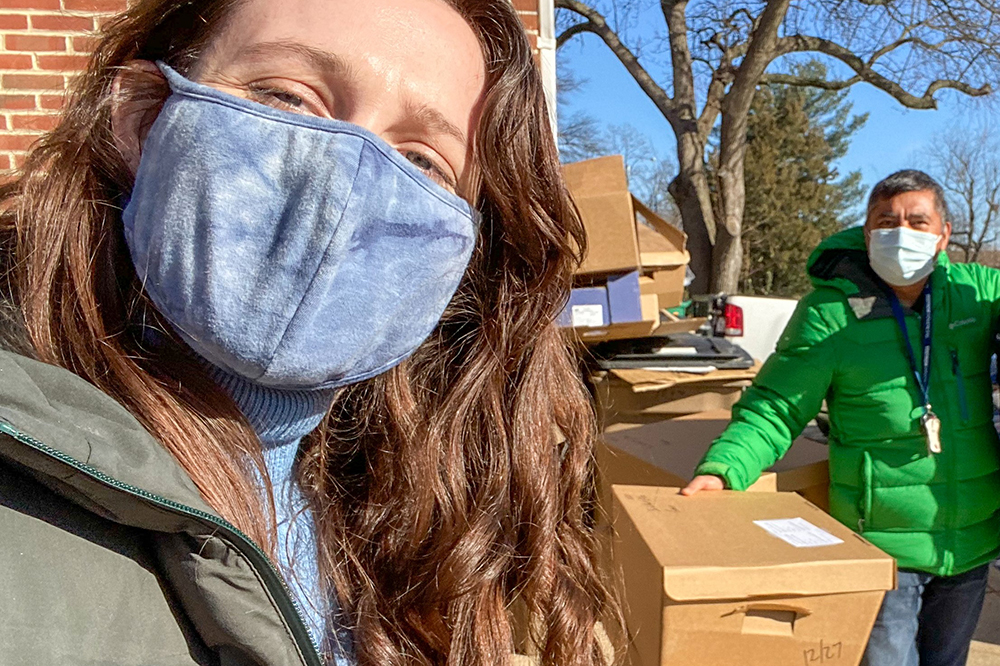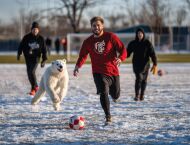Eat
 CFR volunteers. Photo courtesy of Manna’s Community Food Rescue program.
CFR volunteers. Photo courtesy of Manna’s Community Food Rescue program.
Food Rescue + Assistance Programs Fill the Gaps in a Pandemic Food System
April 9, 2021 @ 10:00am
The beginning of the pandemic was a dark time for many. Cities started shutting down, and restaurants and businesses were forced to close their doors. In the early months of the pandemic, Food Rescue US – DC experienced a light through the darkness. In a time when people were advised to stay inside, the organization experienced an influx of new volunteers who wanted to get out and help those around them.
Food Rescue US is a national organization that transports fresh food from local businesses to places like cafeterias, shelters and food banks. There, food that otherwise would have gone to waste can be distributed to people in need: a process that simultaneously combats food waste and hunger. The organization is powered by volunteers who through the Food Rescue US app are alerted of food that needs to be rescued and connected with a food assistance organization in need.
Kate Urbank, site director for Food Rescue US – DC, was surprised by the number of new volunteers when the pandemic began.
“Through the summer, it was 330 brand-new people signed up, and that to me was an example of people who wanted to do something,” Urbank says. “They were at home, had flexible schedules because they were working from home and found out about our opportunity to volunteer.”
During the early days of the pandemic, both the providing and receiving ends of Food Rescue US – DC partners experienced changes, which in turn changed the intermediary work of Urbank and volunteers. When restaurants were forced to close doors, many reached out to donate ingredients that would go bad during their shutdowns. The cafeteria agencies that receive rescued food either closed their doors or had to change their operations to minimize contact with patrons.
“We also had some businesses [that] wanted to keep their cafeteria staff employed,” Urbank adds. “They would pay to have meals made specifically for the purpose of donation. In addition to doing food rescue, which we consider to be food that would otherwise go to waste, we were now transporting meals made specifically for the purpose of feeding the community at a time when they needed food — and also keeping cafeteria members employed.”
Montgomery County-based Community Food Rescue (CFR), a program of Manna Food Center, was experiencing similar changes to their program. Along with changing needs of donors and receiving organizations, CFR also adapted to the needs of Manna. When the pandemic hit, CFR began delivering meals directly to the homes of certain participants of Manna’s programs after it became unsafe for them to come to the center. Between March and December, CFR delivered more than 3,000 meals. The meal delivery effort was taken over by a different department at Manna at the beginning of this year, but CFR continues to expand past their typical food rescue duties.
One project in the works for CFR is a program working with local farmers who will bring farm-fresh produce to assistance organizations. Currently, according to CRF’s program director Cheryl Kollin, the main logistical element still up in the air for the program has to do with the packaging of food when it leaves the farm. Typically, produce is packaged in massive quantities, but the average food assistance organization can only use a fraction of it.
“We are working now with local farms and the Maryland Department of Agriculture to figure out a process by which volunteers can go on farm and repackage the produce into smaller quantities,” Kollin says. “So instead of receiving a huge Gaylord [box] of corn, which might weigh 4,000 pounds, volunteers will subdivide it to say, 12 ears per bag.”
Both Food Rescue US and CFR’s flexibility helped the organizations make the best out of a challenging new supply and demand landscape. For CFR, the already strong and established food rescue program lends itself well to other opportunities that have arisen during the pandemic.
“We want to stay true to our core mission of serving people, but we’re also recognizing that because we have this fabulous mechanism we created, we’re always finding new ways of utilizing Community Food Rescue,” Kollin notes.
Food recovery is just a small part of the solution to a larger problem of food waste, Urbank says.
“Forty percent is usually the percentage people reference as far as what is wasted. It’s wasted at the farm level. It’s wasted scraping off your plates at home or at restaurants. It’s wasted because of expiration dates that don’t make sense, but people get very anxious about.”
Food rescue programs are not the only organizations in the area combating food waste and hunger. Other local organizations also work to provide communities with fresh, healthy and accessible food while reducing waste and using sustainable practices. One example is the Arcadia Center for Sustainable Food and Agriculture, a D.C. area nonprofit with a sustainable farm program and mobile market distribution program. Pamela Hess, Arcadia’s executive director, explains how the organization minimizes waste while serving communities in need.
“Food that is harvested and excess to our market needs (our mobile market, and some of our internal programs and for schools), we donate to food pantries to avoid that food waste,” Hess says.
Arcadia’s mobile market program will begin for the year in May. While sustainably produced and local food is often more expensive than food from the grocery store, Arcadia helps make it affordable and accepts and doubles federal food assistance benefits like the Supplemental Nutrition Assistance Program (SNAP).
Arcadia also helped found the Mid-Atlantic Food Resilience and Access Coalition (MAFRAC), an organization that helps fill gaps in the Covid-strained food system. MAFRAC provides grants of up to $15,000 to organizations and businesses that provide free and reduced-price meals so they can purchase food produced by local farmers.
While food waste and hunger are bigger problems than any individual can solve, becoming a part of the effort to relieve the issues is easy. Those interested in volunteering for Food Rescue US can sign up on their website, where they will then be able to see available rescues and can choose ones that fit their schedule. For CFR, people can sign up on their website, complete a brief food safety training, and then begin accepting and completing food rescues.
“It is fun, quick and really makes you feel good,” Urbank says. “People walk away feeling pretty darn good about themselves, which they should, and Mother Earth thanks them.”
Learn more about Food Rescue US at www.foodrescue.us and follow @foodrescueus.dc on Instagram for D.C.-specific Food Rescue US updates. Learn more about CFR and Manna Food Center at
www.communityfoodrescue.org and www.mannafood.org, or follow @mannafoodcenter on Instagram. For more information about Arcadia and its mobile market program, visit their website at
www.arcadiafood.org.
Enjoy this piece? Consider becoming a member for access to our premium digital content. Support local journalism and start your membership today.







